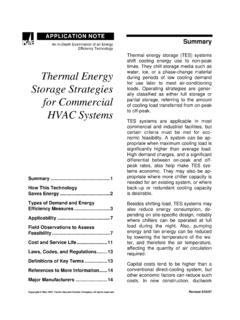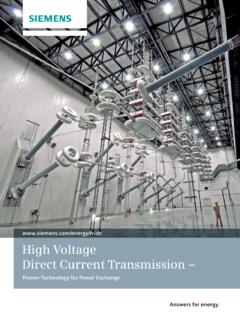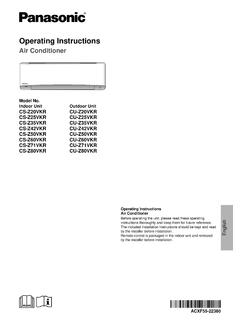Transcription of Substation Maintenance and Construction Manual Circuit ...
1 Table of Contents (continued) pacific GAS AND electric company Substation Maintenance AND Construction Manual Circuit BREAKERS BOOKLET June 2019 Revision 10 i Substation Maintenance and Construction Manual Circuit Breakers Table of Contents Section 1: Introduction .. 1 I. Purpose .. 1 II. 1 A. Manufacturer s Instructions .. 1 B. Using Manual , Slow-Closing Devices .. 1 C. Using and Labeling Manually Actuated, Mechanical Opening Devices .. 1 D. Working on Equipment with Stored-Energy Operators .. 3 E. Working in Elevated Positions and Protecting Bushings .. 3 F. Overstressed Transmission Class Circuit Breakers .. 3 III. General Information .. 7 A. Using Diagrams .. 7 B. Inspecting Insulating Oil or Gas .. 7 C. Working on Relays and Meters .. 7 D. Maintaining Reclosers Used as Substation Circuit Breakers .. 7 E. Adjusting Auxiliary Seal Stack Contacts .. 9 F. Maintaining Bushing-Potential Devices (Ohio Brass Type PB-3A) .. 9 G. Using Heaters .. 9 H. Bypassing a Circuit Breaker With High-Side Bank Protection Only.
2 10 I. Using PK Blocks .. 10 J. Understanding Circuit -Breaker Indicating Lamps .. 11 K. Manufacturer s Assistance .. 13 IV. Performing Periodic Inspections .. 13 V. Performing Periodic Maintenance : Mechanism Service, Overhauls, and Compressor Service .. 14 A. Performing Mechanism Service .. 14 B. Performing an Overhaul .. 14 C. Performing a Compressor Service .. 14 D. Performing a Hydraulic-System Service .. 15 VI. Performing Condition or Trouble Maintenance .. 16 VII. Recordkeeping and Data Entry .. 16 VIII. References .. 16 A. Utility Standards ( company ) .. 16 B. Work Procedures ( company ) .. 17 C. Manuals ( company ) .. 17 D. Engineering Documents ( company ) .. 17 E. Numbered Documents ( company ) .. 17 F. American Society for Testing and Materials (ASTM) 17 G. Other .. 18 June 2019 Revision 10 Substation Maintenance and Construction Manual ii Table of Contents (continued) Section 2: Receiving, Storing, and Installing .. 19 I. Purpose .. 19 II. Receiving Equipment.
3 19 A. Performing Inspections on Delivery .. 19 B. Maintaining Delivery/Damage Records .. 19 III. Storing, Moving, or Relocating Equipment .. 21 A. Decisions to Make Before Storing .. 21 B. General Storage Requirements .. 21 C. Periodically Inspecting and Maintaining Stored Equipment .. 23 D. Recordkeeping for Stored Equipment .. 23 E. Moving or Relocating SF6 Circuit Breakers .. 24 IV. Installing Circuit Breakers .. 24 A. Installation Tasks .. 24 B. Energizing the Circuit Breaker .. 28 C. Inspecting the Circuit Breaker Using Infrared After Installation .. 28 D. Recordkeeping for Installation .. 28 Section 3: Diagnostic Tests .. 29 I. Purpose .. 29 II. Safety Precautions .. 29 III. Performing In-Service 29 A. Safety .. 29 B. Recordkeeping .. 30 C. Infrared Testing .. 30 IV. Performing Out-of-Service Diagnostics .. 30 A. Recordkeeping .. 30 B. Measuring Trip-Voltage and Close-Voltage Signal Levels .. 31 C. Measuring the Resistance of Trip, Close, or Other Control- Circuit Paths.
4 31 D. Performing Minimum-to-Trip and Minimum-to-Close Tests .. 31 E. Performing Insulation Testing on Bushings, Lift Rods, and Rotating Elements .. 35 F. Testing Insulation Resistance of Control Wiring, Current Transformer (CT) Blocks, Etc.. 36 G. Power-Factor Tests .. 37 H. Mechanical Measurements and Tolerances .. 38 I. Pneumatic- or Hydraulic-System Operation .. 38 J. Hydraulic Pre-Charge Pressure .. 40 K. Pressure-Switch Rundown Testing .. 40 L. Contact Pressures .. 41 M. Testing Contact Resistance .. 42 N. Testing Circuit Breakers for Functional Performance .. 49 O. Main-Contact Operating Times .. 59 June 2019 Revision 10 iii Substation Maintenance and Construction Manual Table of Contents (continued) Section 4: Gas Insulated Substations (GIS) .. 61 I. Purpose .. 61 II. Safety Precautions and References .. 61 III. Testing Hybrid Density Monitors .. 61 A. Prior to Testing .. 62 B. Density Monitor Types .. 63 C. Preparing to Test a Trafag Density Monitor (ABB).
5 63 D. Preparing to Test a Hyoda Density Monitor (Mitsubishi) .. 64 E. Testing .. 65 F. Returning to Service .. 66 IV. Accessing GIS Load Path for Electrical Testing .. 66 A. General .. 66 B. Test Equipment .. 67 C. ABB GIS .. 67 D. Mitsubishi (MEPPI) GIS .. 70 E. Returning the GIS to the As-Found 71 Section 5: Metalclad Switchgear .. 73 I. Purpose .. 73 II. Safety Precautions .. 73 A. Personal Protective Equipment (PPE) .. 73 B. Minimum Safe Working Distance .. 73 C. Using Remote Racking Equipment .. 74 D. Using the Maintenance Slow-Closing Device .. 75 E. Precautions for Vacuum Metalclad Switchgear .. 75 F. Protection from High Voltage .. 75 G. Grounding Bus 76 H. Testing Insulation .. 76 I. Ground Knobs .. 77 III. Ground Buggies .. 77 A. Ground-Buggy 77 B. Storing Ground Buggies .. 77 C. Inspecting Ground Buggies .. 77 D. Grounding Procedure .. 78 IV. Flowchart for Periodic Maintenance on Metalclad Circuit Breakers .. 78 V. Inspecting Metalclad Switchgear and Cubicles.
6 78 Substation Maintenance and Construction Manual iv June 2019 Revision 10 Table of Contents (continued) VI. Job Planning Before Maintenance 78 A. Using Manufacturer s Instructions .. 78 B. Checking Records .. 79 C. Relay Service .. 79 D. Performing Mechanism Service for Metalclad Circuit Breakers .. 79 E. Overhauling Metalclad Circuit Breakers .. 79 F. Tools and Materials .. 79 VII. Performing Mechanism Service for All Types of Metalclad Switchgear .. 81 A. Clearance .. 82 B. Fasteners .. 82 C. Wire Terminations .. 82 D. Switches and Relays .. 82 E. 82 F. Insulation, Insulators, and Bushings .. 82 G. Primary-Coupling Contacts .. 83 H. Shock Absorbers and Dashpots .. 83 I. Cleaning and Inspecting Vacuum and SF6 Interrupter Bottles .. 84 J. Checks Requiring Manual Closing .. 84 K. Testing Alarms, Relays, and Reclosers .. 84 L. Indicators .. 85 M. Lockout Devices .. 85 N. Cleaning and 85 O. Trip Shafts .. 85 P. Compartments .. 85 Q. Contact and Interrupter Wear.
7 85 R. Performing High-Pot Tests for Metalclad Vacuum and SF6 Circuit Breakers .. 86 S. Insulation Resistance Tests .. 86 T. Minimum-to-Trip and Minimum-to-Close Tests .. 87 U. Anti-Pump Feature .. 87 V. As-Left Functional-Performance Test .. 87 W. Main-Contact Operating Times .. 88 X. Cubicle Maintenance .. 88 Y. Operational Checks .. 88 VIII. Overhauling Metalclad Switchgear .. 88 A. Clearing the Circuit Breaker .. 88 B. Performing Mechanism Service .. 89 C. Filtering and Testing Oil .. 89 D. Testing Contact Resistance .. 89 E. Mechanical Measurements .. 89 F. Determining Safety and Reliability .. 89 June 2019 Revision 10 v Substation Maintenance and Construction Manual Table of Contents (continued) IX. Maintaining GE-Type AM 15-500-2 Circuit Breakers .. 89 A. Lubricating .. 90 B. Disassembling and Servicing .. 90 C. AM 15-500 Supplemental Maintenance Record .. 103 X. Maintaining Cubicles .. 109 A. Moisture in Cubicles .. 109 B. Dirty Cubicles .. 109 C. Racking Mechanism, Gears, and Chains.
8 110 D. Shutter and Interlock Mechanisms .. 110 E. Bushings and Insulation .. 110 F. Bus Conductors and Connections .. 110 G. Rodent Infestation .. 111 H. Cable Ducts .. 111 I. Cubicle Ventilation .. 111 J. Fire Ducts .. 111 K. Associated Compartments .. 111 L. Automatic Grounding Devices .. 111 M. Control-Coupling Contacts .. 111 N. Interlocks .. 112 O. Ground-Shoe Connections .. 112 P. Control Contactor, Rectifier, and Solenoid .. 112 Q. Lights and Plugs .. 112 R. Switches and Wiring .. 112 S. Door Gaskets .. 112 T. Door Latches .. 112 U. Metalclad Circuit Breakers Using Compressed Air .. 112 V. Checks Following Maintenance .. 113 W. Testing Insulation .. 113 Section 6: Oil Circuit Breakers .. 115 I. Purpose .. 115 II. Safety Precautions .. 115 A. BZO-Type OCBs .. 115 B. Confined Spaces .. 115 C. Bushing Mounting Studs .. 115 D. Power Close and Open Operations .. 115 III. References .. 115 A. Bushings .. 115 B. Handling Oil .. 116 C. Work-Area Protection.
9 116 IV. Testing and Analyzing Oil .. 116 Substation Maintenance and Construction Manual vi June 2019 Revision 10 Table of Contents (continued) V. Flowcharts for Periodic OCB Maintenance .. 116 VI. Planning the Job Before Performing OCB Maintenance Work .. 116 A. Using Manufacturer s Instructions .. 116 B. Checking Records .. 116 C. Relay Service .. 117 D. OCB Mechanism Service .. 117 E. OCB Overhaul .. 117 F. Routine Inspection Items .. 118 G. Testing and Maintaining Bushings .. 118 H. Preventing Moisture .. 118 I. Tools and Materials .. 118 VII. Performing an OCB Mechanism Service .. 120 A. Clearance .. 120 B. Fasteners .. 120 C. Electrical Wire Terminations .. 120 D. Switches and Relays .. 121 E. Checks Requiring Slow Closing .. 121 F. Testing Alarms, Relays, and Reclosers .. 121 G. Indicators .. 121 H. Lockout Devices .. 122 I. Cleaning and 122 J. Compartments .. 122 K. Compressor and Hydraulic Service .. 122 L. Minimum-to-Trip and Minimum-to-Close Tests.
10 123 M. Anti-Pump Feature .. 123 N. As-Left Functional-Performance Test and Verifying Trip-Free Operation .. 124 O. Main-Contact Operating Times .. 124 P. As-Left Speed Shot .. 124 Q. BOA .. 124 R. Checks Following Service .. 124 S. Determining Safety and Reliability .. 124 T. Operational Checks .. 125 VIII. Overhauling the OCB .. 125 A. Functional-Performance Test .. 125 B. Clearance .. 125 C. Contact-Resistance Readings .. 125 D. Cleaning the Tanks .. 125 E. Inspecting Internal Components .. 126 F. Interrupters .. 126 G. Contact Wear .. 126 June 2019 Revision 10 vii Substation Maintenance and Construction Manual Table of Contents (continued) H. Checks Requiring Slow Closing .. 127 I. Contact Measurements .. 127 J. Oil Indicators and Leaks .. 127 K. Shock Absorbers and Dashpots .. 127 L. Rotating-Contact Elements .. 127 M. Checking the Tanks .. 127 N. Testing Oil .. 127 O. Pressure-Switch Rundown and Relief-Valve Tests .. 128 P. As-Left Speed Shot.
















